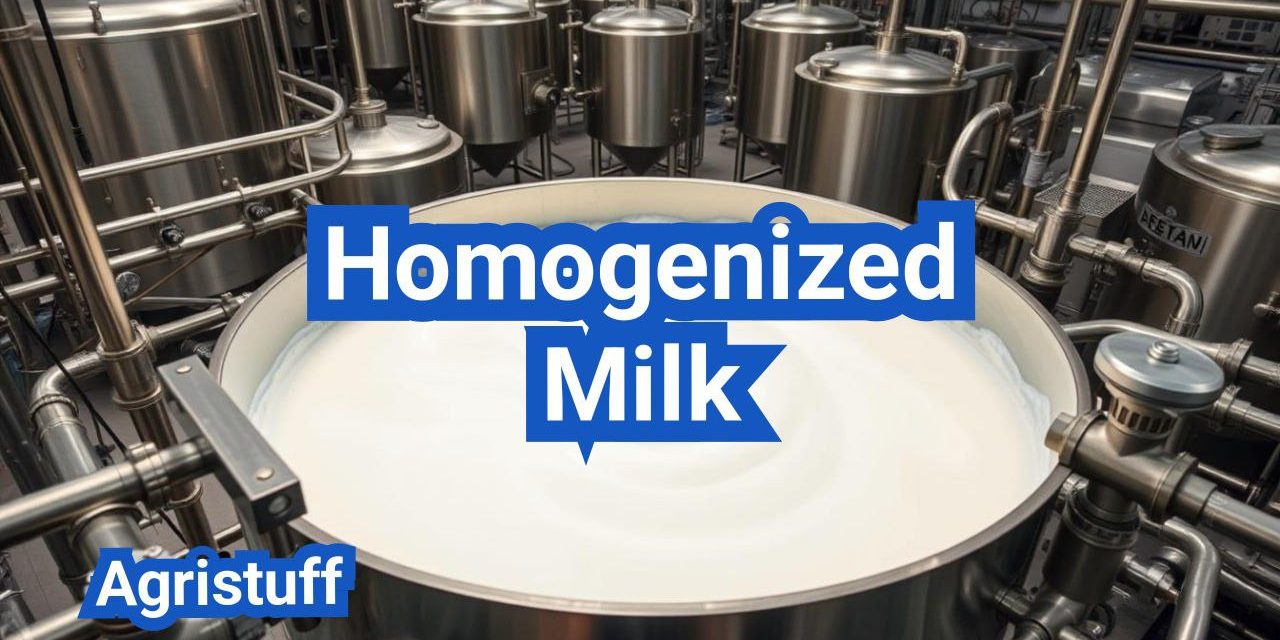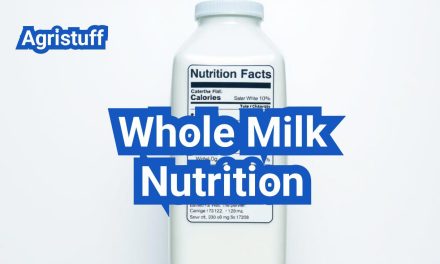The dairy industry has undergone significant transformations to improve the quality and consistency of milk products. One such process is homogenization, which has become a standard step in dairy processing. But what exactly is homogenized milk, and why does it taste different?
Homogenization is a process that involves mixing and dispersing milk fat globules to prevent separation. This results in a uniform texture and flavor. The process has a significant impact on the overall quality of the milk, making it more appealing to consumers.
Key Takeaways
- The homogenization process improves the texture and flavor of milk.
- Homogenized milk has a uniform consistency.
- The dairy industry uses homogenization to enhance milk quality.
- Milk homogenization is a crucial step in dairy processing.
- The process prevents milk from separating.
What Is Homogenized Milk?
Understanding homogenized milk requires a look into its definition and historical background. Homogenized milk is a type of milk that has been processed to ensure that the fat molecules are evenly distributed, preventing cream from separating and rising to the top.
Definition and Basic Concept
Homogenization is a mechanical process that forces milk through a small opening under high pressure, breaking down the fat molecules into smaller particles. This results in a uniform consistency and taste throughout the milk. The primary goal of homogenization is to create a stable emulsion, where the fat globules remain suspended in the milk, improving its overall appearance and shelf life.
Historical Development of Milk Homogenization
The concept of milk homogenization dates back to the late 19th century. It became a standard practice in the dairy industry as a method to improve milk’s consistency and appearance without using additives or chemical treatments. Over time, the technology behind homogenization has evolved, with modern equipment allowing for more efficient and precise control over the homogenization process.
The historical development of milk homogenization is closely tied to advancements in dairy processing technology. As the demand for consistent and high-quality milk products grew, so did the need for effective homogenization techniques.
The Science Behind Milk Fat and Separation

The phenomenon of milk separation is rooted in the physical properties of milk fat globules and their interaction with the surrounding milk plasma. Milk, being a complex mixture of water, carbohydrates, proteins, and fats, exhibits this separation due to the inherent characteristics of its components.
Understanding Milk Fat Globules
Milk fat globules are tiny, spherical particles that contain the fat component of milk. These globules are surrounded by a membrane derived from the mammary gland cell membrane, known as the milk fat globule membrane (MFGM). The size and distribution of these globules vary, influencing the overall fat content and the stability of the milk emulsion.
The MFGM plays a crucial role in maintaining the integrity of the fat globules and preventing them from coalescing. However, the natural tendency of these globules is to rise to the surface due to their lower density compared to the surrounding milk plasma, leading to the formation of a cream layer.
Why Natural Milk Separates
Natural milk separates because the milk fat globules tend to rise to the surface, creating a distinct layer of cream. This separation occurs due to the difference in density between the fat globules and the skim milk. Over time, as the globules coalesce and rise, the cream layer becomes more pronounced, resulting in the characteristic separation observed in unhomogenized milk.
The rate and extent of this separation can be influenced by factors such as the size of the fat globules, the storage conditions of the milk, and the handling practices. Understanding these factors is crucial for dairy processors aiming to either preserve or alter the natural separation characteristics of milk.
How Homogenized Milk Is Processed
The processing of homogenized milk involves several critical steps that transform raw milk into a consistent and high-quality product. This process is designed to ensure that the final product has a uniform taste, texture, and appearance. Understanding these steps is essential to appreciating the technology and care that goes into producing homogenized milk.
Step1: Preparation of Raw Milk
The first step in processing homogenized milk is the preparation of raw milk. This involves receiving raw milk from dairy farms, storing it in silos, and then testing it for quality and purity. The raw milk is then standardized to achieve the desired fat content, which is crucial for the production of homogenized milk.
Step2: High-Pressure Processing
High-pressure processing is a critical step in the homogenization of milk. During this process, the milk is forced through a narrow valve under high pressure, typically between 1,000 to 2,000 psi. This high pressure breaks down the fat globules in the milk, making them smaller and more uniform, which prevents the cream from separating and gives homogenized milk its characteristic consistency.
The high-pressure processing step is crucial for achieving the desired consistency and quality in homogenized milk. By breaking down the fat globules, it ensures that the milk remains uniform throughout its shelf life. This process also contributes to the improved digestibility of homogenized milk.
Step3: Size Reduction of Fat Globules
The final step in the processing of homogenized milk is the size reduction of fat globules. As a result of high-pressure processing, the fat globules are not only broken down but also become more evenly distributed throughout the milk. This uniform distribution of fat globules is what gives homogenized milk its smooth texture and prevents the separation of cream, making it more appealing to consumers.
In conclusion, the processing of homogenized milk involves a series of precise steps, from the preparation of raw milk to high-pressure processing and the size reduction of fat globules. Each step plays a vital role in producing a high-quality product that meets consumer expectations for taste, texture, and consistency.
Types of Homogenization Methods

Homogenization methods vary, each with its own benefits and applications in the dairy industry. The choice of method depends on the desired outcome, whether it’s improving the texture, enhancing the shelf life, or achieving a specific consistency in milk products.
Two-Stage Homogenization Process
The two-stage homogenization process is a widely adopted technique that involves two consecutive homogenization steps. This method ensures a more uniform distribution of fat globules in milk.
How Two-Stage Processing Works
In the first stage, milk is subjected to high pressure to break down the fat globules. The partially homogenized milk then passes through a second homogenization stage, where it is subjected to lower pressure. This two-stage process results in a more stable emulsion.
Advantages of Two-Stage Homogenization
The two-stage homogenization process offers several advantages, including improved fat distribution, reduced cream separation, and enhanced overall quality of the milk. As noted by dairy experts, “Two-stage homogenization is particularly effective in producing milk with a consistent texture and appearance.”
High-Pressure Homogenization (HPH)
High-Pressure Homogenization (HPH) is another significant method used in the dairy industry. This technique involves forcing the milk through a narrow valve under extremely high pressure, resulting in the disruption of fat globules.
Pressure Levels and Their Effects
The pressure levels applied during HPH can significantly affect the final product. Higher pressures result in smaller fat globules, leading to a more stable and consistent milk texture.
Applications in Dairy Industry
HPH is used in various dairy applications, including the production of milk, cream, and yogurt. Its ability to improve the texture and extend the shelf life of dairy products makes it a valuable technique in modern dairy processing.
Homogenization Equipment and Technology
Homogenization equipment plays a crucial role in the dairy industry by ensuring the uniform distribution of fat globules in milk. This uniformity is essential for the quality and consistency of dairy products.
Milk Homogenizers: How They Work
Milk homogenizers are specialized machines designed to break down fat globules into smaller particles, ensuring they remain suspended in the milk. This process involves forcing the milk through a narrow passage under high pressure, typically between 1,000 to 2,000 psi. The high-pressure processing reduces the size of the fat globules, making the milk more stable and consistent.
The efficiency of milk homogenizers is critical in achieving the desired product quality. Modern homogenizers are designed to handle large volumes and can be adjusted to achieve the specific fat globule size required for different dairy products.
Modern Innovations in Homogenization Technology
Recent advancements in homogenization technology have led to more efficient and effective processing. One such innovation is the two-stage homogenization process, which further ensures the uniform distribution of fat globules. This process involves a second stage of homogenization at a lower pressure, which helps in achieving a more consistent product.
The table below highlights some key features of modern homogenization equipment:
| Feature | Description | Benefit |
|---|---|---|
| High-Pressure Processing | Forces milk through a narrow passage | Reduces fat globule size |
| Two-Stage Homogenization | Involves two stages of homogenization | Ensures uniform fat distribution |
| Adjustable Pressure | Allows for different fat globule sizes | Flexible for various dairy products |
Homogenized Milk vs. Whole Milk: Key Differences

Homogenized milk and whole milk are two types of milk products that differ significantly in their processing methods and final product characteristics. While both types of milk come from the same source, their differences in composition, taste, and texture are notable.
Composition Comparison
The primary difference between homogenized and whole milk lies in their fat globule distribution. Homogenized milk has undergone a process that breaks down fat globules into smaller, uniform particles, ensuring they remain suspended in the milk. In contrast, whole milk has not undergone this process, resulting in a natural separation of cream from the skim milk. Here are the key composition differences:
- Fat Distribution: Homogenized milk has a uniform fat distribution, while whole milk has a natural separation.
- Nutritional Content: Both types of milk have similar nutritional profiles, but homogenization can affect the milk fat globule membrane (MFGM).
Taste and Texture Differences
The differences in processing between homogenized and whole milk also affect their taste and texture. Homogenized milk has a smoother, creamier texture due to the uniform distribution of fat globules. Whole milk, on the other hand, can have a richer, more natural taste, with the cream separating and rising to the top.
The taste and texture differences can be summarized as follows:
- Texture: Homogenized milk is smoother, while whole milk can be richer and creamier at the top due to cream separation.
- Taste: The taste of homogenized milk is often described as consistent, whereas whole milk can have a more varied taste experience due to the separation of cream.
Homogenized Milk vs. Non-Homogenized Milk

Understanding the differences between homogenized and non-homogenized milk requires examining their processing techniques and resulting characteristics. Homogenized milk undergoes a process that ensures the fat molecules are evenly distributed, whereas non-homogenized milk does not undergo this process, leading to a natural separation of cream from the skim milk.
Physical and Chemical Differences
The primary physical difference between homogenized and non-homogenized milk is the size of the fat globules. In homogenized milk, these globules are reduced in size, making the milk more uniform in consistency. Non-homogenized milk, on the other hand, retains its larger fat globules, which can rise to the top, forming a cream layer. This difference significantly affects the appearance and texture of the milk.
Chemically, both types of milk have similar compositions, with the same amounts of fat, protein, and other nutrients. However, the process of homogenization can affect the milk fat globule membrane (MFGM), potentially making the fat more accessible to enzymes.
Shelf Life and Storage Considerations
Non-homogenized milk tends to have a shorter shelf life compared to homogenized milk due to its potential for greater bacterial growth in the cream layer. However, proper storage can mitigate this issue. Both types of milk should be refrigerated at a temperature below 40°F (4°C).
| Characteristics | Homogenized Milk | Non-Homogenized Milk |
|---|---|---|
| Fat Globule Size | Reduced | Natural/Larger |
| Appearance | Uniform | Separation of Cream |
| Shelf Life | Longer | Shorter |
In conclusion, while both homogenized and non-homogenized milk have their unique characteristics, the choice between them often comes down to personal preference, intended use, and storage capabilities.
Understanding Creamline Milk

Consumers are increasingly seeking out creamline milk, driven by a desire for less processed dairy products. Creamline milk, also known as non-homogenized milk, retains its natural layering of cream and milk, distinguishing it from the more commonly consumed homogenized milk.
What Makes Creamline Milk Different
Creamline milk is different from homogenized milk in its processing. Unlike homogenized milk, where fat molecules are broken down and distributed evenly throughout, creamline milk is not subjected to this high-pressure process. As a result, the cream in creamline milk rises to the top, creating a distinct cream line.
This natural separation allows consumers to control the amount of cream they mix with their milk, catering to individual preferences. The table below highlights key differences between creamline and homogenized milk.
| Characteristics | Creamline Milk | Homogenized Milk |
|---|---|---|
| Processing | Not homogenized | High-pressure homogenization |
| Fat Distribution | Natural separation | Even distribution |
| Consumer Control | Can mix cream as desired | Fixed fat content |
Growing Popularity of Non-Homogenized Options
The popularity of creamline milk is growing as consumers become more interested in less processed foods and beverages. This trend is driven by a desire for products that are perceived as more natural and less manipulated by processing technologies.
Key factors contributing to its popularity include:
- Perceived health benefits
- Desire for natural products
- Increased control over milk composition
Creamline milk offers consumers a unique dairy experience, combining tradition with the flexibility to adjust the cream content to their liking. As the demand for less processed dairy products continues to grow, the popularity of creamline milk is likely to increase.
Pasteurization and Homogenization: Related but Different

While often discussed together in the context of milk processing, pasteurization and homogenization serve distinct purposes. Pasteurization is a process that involves heat treatment to kill harmful bacteria, whereas homogenization is a mechanical process that breaks down fat globules to ensure uniform distribution.
How Pasteurization Works
Pasteurization involves heating milk to a high temperature for a short period, followed by rapid cooling. This process effectively eliminates pathogens, extending the shelf life of milk. The most common method is High-Temperature Short-Time (HTST) pasteurization, where milk is heated to at least 161°F (72°C) for 15 seconds. Pasteurization is crucial for ensuring the safety of milk for consumption, as it reduces the risk of milkborne illnesses.
Combining Pasteurization with Homogenization
In modern dairy processing, pasteurization and homogenization are often combined to achieve both safety and consistency in milk products. After pasteurization, milk is typically homogenized to prevent cream separation and ensure a uniform texture. This combination is particularly important for products like milk and cream, where appearance and consistency are key factors. By integrating these processes, dairy manufacturers can produce high-quality products that meet consumer expectations.
The synergy between pasteurization and homogenization highlights the complexity and sophistication of modern dairy processing. While they are distinct processes, together they contribute to the production of safe, high-quality milk products.
The Role of Milk Fat Globule Membrane (MFGM)

Understanding the MFGM is essential to grasping how milk processing affects its nutritional properties. The milk fat globule membrane (MFGM) is a complex structure that surrounds fat globules in milk, playing a crucial role in their stability and digestion. As research highlights the importance of MFGM in milk’s nutritional profile, it’s clear that its role is multifaceted.
Structure and Function of MFGM
The MFGM is composed of a trilayer structure, including phospholipids and proteins. This membrane is vital for maintaining the integrity of fat globules and facilitating their digestion in the human body. The MFGM’s unique composition allows it to interact with various enzymes and receptors, enhancing the bioavailability of milk nutrients. As stated by a recent study, “The MFGM is not just a passive barrier; it actively influences the digestion and absorption of milk fat.”
How Homogenization Affects MFGM
Homogenization significantly impacts the MFGM by breaking down fat globules into smaller sizes, thereby increasing their surface area. This process can lead to changes in the MFGM’s structure and function, potentially affecting the nutritional properties of milk. The disruption of MFGM during homogenization may result in the loss of some of its native properties, influencing milk’s overall nutritional value. As noted by experts, “The effect of homogenization on MFGM is a critical factor in determining the final product’s quality and nutritional characteristics.”
Benefits of Homogenized Milk

Homogenized milk offers several advantages that make it a popular choice among consumers. The process of homogenization enhances the overall quality and usability of milk, providing a consistent product that meets consumer expectations.
Consistency and Appearance Benefits
One of the primary benefits of homogenized milk is its uniform texture and consistency. Unlike non-homogenized milk, where fat globules separate and rise to the top, homogenized milk maintains a consistent appearance and taste throughout. This consistency is particularly important for consumers who value a predictable product.
Digestibility Considerations
Homogenized milk may also offer digestibility advantages for some consumers. The smaller fat globules resulting from homogenization can be more easily broken down by digestive enzymes, potentially making it easier to digest for individuals with certain sensitivities.
Commercial and Processing Advantages
From a commercial perspective, homogenized milk offers several processing advantages. The uniform distribution of fat globules simplifies packaging and storage, as the milk does not require shaking or mixing before consumption. This consistency also aids in the production of dairy products, where uniform milk quality is crucial.
| Benefits | Description |
|---|---|
| Consistency | Uniform texture and appearance |
| Digestibility | Easier breakdown of fat globules |
| Commercial Advantages | Simplified packaging and storage |
Potential Concerns About Homogenized Milk
Despite its widespread consumption, homogenized milk has raised several concerns among consumers and health experts alike. The process of homogenization, while beneficial for extending shelf life and improving appearance, has been scrutinized for its potential impact on nutritional quality and digestibility.
Examining Health Claims and Controversies
Some health claims suggest that homogenization can damage the natural structure of milk fat globules, potentially affecting their nutritional value. Critics argue that this process might make milk less healthy or more difficult to digest for some individuals. However, it’s crucial to examine the scientific evidence supporting or refuting these claims.
Research on the health implications of homogenized milk has yielded mixed results. Some studies indicate that the changes in milk fat globules due to homogenization could influence the way the body processes milk fat. Conversely, other research suggests that homogenization has minimal impact on the nutritional quality of milk.
Scientific Perspective on Homogenization Safety
From a scientific standpoint, the safety of homogenized milk is supported by numerous regulatory agencies worldwide. These organizations have established guidelines for the homogenization process to ensure it does not compromise the safety or nutritional value of milk.
While some controversy surrounds homogenized milk, the consensus among health and food safety authorities is that it is safe for consumption. Ongoing research continues to monitor its effects and provide insights into any potential long-term implications.
How to Identify and Use Different Types of Milk
Navigating the dairy aisle can be challenging, but understanding the differences between homogenized and non-homogenized milk can simplify the process. To make informed choices, consumers need to know how to read milk labels correctly and understand the best uses for different types of milk.
Reading Milk Labels Correctly
To identify the type of milk, start by reading the label. Look for keywords like “homogenized” or “non-homogenized.” Some labels may also indicate if the milk has undergone ultra-high temperature (UHT) processing or if it’s raw. Understanding these terms can help you make the right choice for your needs.
Best Uses for Homogenized Milk
Homogenized milk is ideal for cooking, baking, and making beverages like lattes and smoothies. Its uniform consistency ensures that it mixes well with other ingredients and provides a consistent taste. For recipes that require a smooth texture, homogenized milk is the best choice.
When to Choose Non-Homogenized Alternatives
Non-homogenized milk, also known as creamline milk, is perfect for those who prefer a more natural, traditional milk experience. It’s great for cereal, coffee, or simply drinking straight. If you enjoy the separation of cream and milk, non-homogenized is the way to go.
Milk Standards and Regulations
Milk standards and regulations play a crucial role in ensuring the quality of dairy products. These regulations are designed to protect consumer health and maintain fair practices within the dairy industry.
PMO Milk Standards
The Pasteurized Milk Ordinance (PMO) is a key regulatory framework governing milk production and processing in the United States. It sets forth standards for the handling, processing, and distribution of milk to ensure safety and quality. The PMO guidelines cover aspects such as sanitation, labeling, and testing procedures.
Key aspects of PMO standards include:
- Sanitation requirements for dairy farms and processing facilities
- Standards for milk composition and purity
- Labeling requirements for milk and dairy products
Labeling Requirements (21 CFR 131.110)
The FDA regulates milk labeling under 21 CFR 131.110, which outlines specific requirements for the labeling of milk products. This includes information such as the type of milk (e.g., whole, low-fat, or skim), nutritional content, and any additives or processing methods used.
Accurate labeling is crucial for consumer information and safety. As stated by the FDA, “Labeling requirements help ensure that consumers are informed about the products they purchase.”
Alternative Processing Methods
Innovations in dairy processing, such as microfiltration, are offering new possibilities for milk production. As the dairy industry continues to evolve, alternative milk processing methods are being explored to improve efficiency, quality, and consumer satisfaction.
Microfiltration and Other Emerging Technologies
Microfiltration is a membrane-based process that removes bacteria and other microorganisms from milk, extending its shelf life without heat treatment. Other emerging technologies include high-pressure processing and ultrasonic processing, which can improve milk’s safety and quality.
Comparing Results with Traditional Homogenization
When comparing microfiltration to traditional homogenization, several differences emerge. The following table summarizes key aspects:
| Processing Method | Effect on Fat Globules | Shelf Life Impact |
|---|---|---|
| Traditional Homogenization | Reduces size, increases uniformity | Minimal direct impact |
| Microfiltration | No direct effect on fat globules | Extends shelf life by removing bacteria |
The Future of Homogenized Milk
The future of homogenized milk is closely tied to trends in dairy processing and shifting consumer preferences. As consumers become more health-conscious and environmentally aware, dairy processors are adapting to meet these demands.
Technological advancements in homogenization, such as high-pressure processing, are enhancing the quality and consistency of homogenized milk. These innovations are likely to continue shaping the industry, offering consumers a wider range of choices.
Consumer preferences are driving the demand for more sustainable and environmentally friendly dairy products. In response, manufacturers are exploring new packaging options and production methods that reduce waste and environmental impact.
As the dairy industry continues to evolve, homogenized milk is expected to remain a staple in many markets. Its widespread acceptance and the benefits it offers in terms of consistency and shelf life make it a popular choice among consumers.
FAQ
What is homogenized milk?
Homogenized milk is milk that has been processed to ensure the fat molecules are evenly distributed throughout, preventing separation and giving it a uniform consistency.
How is milk homogenized?
Milk is homogenized by forcing it through a small opening under high pressure, breaking down the fat molecules into smaller particles that remain suspended in the milk.
What is the difference between homogenized and non-homogenized milk?
The main difference is that homogenized milk has a uniform consistency due to the even distribution of fat molecules, while non-homogenized milk separates into cream and skim milk over time.
Is homogenized milk whole milk?
Homogenized milk can be whole milk if it contains the standard 3.5% fat content, but homogenization is a process that can be applied to milk of any fat content.
What is the purpose of homogenization in milk processing?
Homogenization ensures a consistent texture and appearance, making it more appealing to consumers and easier to process into various dairy products.
How does homogenization affect the nutritional content of milk?
Homogenization does not significantly alter the nutritional content of milk; it primarily affects the physical structure of the fat molecules.
Are there different methods of homogenization?
Yes, there are different methods, including two-stage homogenization and high-pressure homogenization (HPH), each with its own applications and benefits.
What is creamline milk?
Creamline milk, also known as non-homogenized milk, is milk that has not been processed to distribute the fat molecules evenly, allowing it to separate into cream and skim milk.
Is homogenized milk pasteurized?
Homogenized milk is often pasteurized, but the processes are distinct; homogenization affects the fat distribution, while pasteurization involves heat treatment to kill bacteria.
How do I identify homogenized milk when shopping?
Check the milk label; if it’s labeled as “homogenized” or there’s no mention of it being non-homogenized, it’s likely homogenized.
What are the benefits of homogenized milk?
Benefits include a consistent appearance, potential digestibility advantages, and commercial benefits for dairy processors.
Are there any health concerns associated with homogenized milk?
Some concerns have been raised, but scientific evidence generally supports the safety of homogenized milk.
Can I make homogenized milk at home?
While possible, making homogenized milk at home requires specialized equipment, such as a high-pressure homogenizer, which is not typically available for household use.
What is the role of MFGM in milk?
The Milk Fat Globule Membrane (MFGM) surrounds the fat globules in milk, playing a crucial role in their stability and nutritional properties.
How does homogenization affect MFGM?
Homogenization can disrupt the MFGM, potentially affecting the nutritional and physical properties of the milk.
Are there regulations governing milk labeling and standards?
Yes, regulations such as the Pasteurized Milk Ordinance (PMO) and FDA labeling requirements (21 CFR131.110) govern milk standards and labeling.
What are alternative processing methods to homogenization?
Alternative methods include microfiltration, which can achieve similar consistency without high pressure, offering different outcomes and applications.
Conclusion of: Homogenized Milk In USA
What homogenized milk is (quick definition)
Homogenized milk is regular cow’s milk that has been pushed at very high pressure through tiny openings so the fat globules shatter into microscopic droplets and stay evenly dispersed, which prevents a cream layer from forming and gives homogenized milk its uniform, smooth appearance and mouthfeel. What is homogenized milk? — U.S. Dairy
Homogenized milk vs. pasteurized milk
Homogenized milk is about texture and stability, while pasteurization is a separate heat step that makes milk safer by reducing harmful microbes; most U.S. cartons contain pasteurized and homogenized milk, but it’s useful to remember these are different processes with different purposes when you evaluate homogenized milk on the shelf. Raw milk vs. pasteurized — FDA
How homogenized milk is processed (the short version)
To create homogenized milk, dairies usually warm milk, then run it through a two-stage valve homogenizer: the first stage uses very high pressure to break up fat droplets, and the second stage prevents them from clustering, leaving homogenized milk with stable, tiny droplets that won’t rise to form a cream cap. Homogenization of milk — University of Guelph
What changes inside homogenized milk at the microscopic level
During homogenization the native milk fat globule membrane (MFGM) is disrupted and quickly replaced by casein and whey proteins, forming a new interfacial layer around the tiny fat droplets; that protein “jacket” helps homogenized milk resist creaming and coalescence, preserving a uniform texture for longer. Milk fat globule structure — NIH/PMC
Why homogenized milk looks whiter and tastes smoother
Smaller, well-dispersed particles in homogenized milk scatter light more effectively and increase perceived whiteness while a finer emulsion and protein-coated droplets contribute to a creamier, rounder mouthfeel even at the same fat percentage—one reason many consumers prefer homogenized milk for everyday drinking. MFG size & color in milk — NIH/PMC
Why homogenized milk doesn’t form a cream layer
Before processing, large fat globules naturally rise and form a cream line; in homogenized milk, the dramatically smaller, protein-stabilized droplets have far less buoyancy and reduced tendency to clump, so homogenized milk stays uniform from top to bottom even after days in the refrigerator. Fluid milk processing — Penn State Extension
Nutritional impact of homogenized milk
Homogenization is a mechanical process, not a compositional one, so the macronutrients and labeled vitamins and minerals remain the same; homogenized milk has its fat, protein, calcium, and vitamins intact, with the main difference being structure and texture rather than nutrition content. Homogenized milk basics — U.S. Dairy
Health claims about homogenized milk (what the science says)
Some online claims link homogenized milk to heart disease or allergies, but peer-reviewed reviews report no credible evidence that homogenization itself causes cardiovascular problems; altering droplet size mainly changes physical stability, not the underlying risk profile of homogenized milk in balanced diets. Homogenization & health — PubMed
Where homogenized milk fits in U.S. rules and plant design
Commercial plants integrate homogenizers within pasteurization systems that meet the Grade “A” Pasteurized Milk Ordinance (PMO), with controls and safeguards to ensure time-temperature compliance and sanitary operation so homogenized milk meets national public-health standards before shipping. Grade “A” PMO — FDA (PDF)
How homogenized milk is labeled in the U.S.
Under federal standards of identity, milk may be labeled “homogenized” if it has been homogenized; you’ll often see “homogenized” on the principal display panel or near Nutrition Facts, which helps shoppers quickly identify homogenized milk for consistent texture. 21 CFR §131.110 Milk — GovInfo (PDF)
Homogenized milk vs. “cream-top” milk
Non-homogenized or “creamline” milk naturally develops a rich cream layer that you shake in before pouring, while homogenized milk remains uniformly mixed; both are pasteurized in mainstream retail, but homogenized milk delivers a more predictable mouthfeel for coffee, sauces, and daily use. Homogenized vs. non-homogenized — American Dairy Association NE
Why baristas and cooks often choose homogenized milk
Because droplet size and protein interfaces influence foam and texture, homogenized milk typically produces more stable microfoam for lattes and a reliable emulsion in soups and sauces, giving professionals a repeatable result that’s harder to achieve with non-homogenized milk. Milk foams & processing — Food Engineering Reviews
Cheese making considerations with homogenized milk
Cheesemakers often avoid fully homogenized milk for many aged styles because tiny, protein-coated fat droplets alter curd formation and yield softer textures, though partial or cream-only homogenization can be useful for certain fresh or spreadable cheeses, unlike standard homogenized milk for drinking. Milk treatment for cheese — Guelph Cheesemaking eBook
Typical pressures and equipment for homogenized milk
Industrial homogenizers for fluid products operate at high pressures and precise temperatures to achieve target droplet sizes, with two-stage units standard for fluid homogenized milk and specialized designs used for creams, yogurts, and other dairy products requiring tailored textures. Homogenization overview — Tetra Pak
High-pressure homogenization research and homogenized milk
Beyond conventional pressures, studies on high-pressure homogenization (HPH) explore even finer droplet distributions and modified interfaces to tune color, viscosity, and stability, potentially expanding how homogenized milk and related dairy systems are engineered for specific sensory outcomes. High-pressure homogenization review — NIH/PMC
Shelf life: what homogenized milk can and can’t do
Homogenized milk resists creaming but it doesn’t prevent microbial spoilage; processors combine homogenization with pasteurization, sanitation, and sometimes microfiltration or extended processes to reach longer refrigerated shelf life while maintaining the clean flavor of homogenized milk. Long-life refrigerated milk — Journal of Dairy Science
Safe storage for homogenized milk at home
For best quality, keep homogenized milk at or below 40°F (4°C), return it to the refrigerator quickly, and store it in the coldest section rather than the door to minimize temperature swings that can hasten spoilage in any milk, including homogenized milk. Cold storage guidance — FDA
How long can homogenized milk sit out?
Even though it won’t separate, homogenized milk should not sit at room temperature; as a practical rule, limit time in the “danger zone” and return it to the fridge promptly so homogenized milk keeps its flavor and stays within recommended food-safety practices. Time & temperature tips — U.S. Dairy
Common myths about homogenized milk
Some confusion around homogenized milk comes from mixing it up with raw milk debates; regardless of cream separation, the safety of retail milk comes from pasteurization and hygienic processing, and homogenized milk in stores is overwhelmingly pasteurized in accordance with U.S. regulations. Raw milk safety Q&A — CDC
Homogenized milk and lactose intolerance
Homogenized milk does not change lactose content; people who are lactose intolerant may opt for lactose-free homogenized milk, where the lactose is enzymatically broken down, preserving the same texture benefits of homogenized milk without the digestive discomfort. Lactose intolerance — NIH/NIDDK
Dietary guidance that includes homogenized milk
Within the U.S. Dietary Guidelines, dairy foods—including homogenized milk—are recommended as part of healthy patterns for most Americans because they provide high-quality protein, calcium, potassium, vitamin D (if fortified), and other nutrients valuable for overall health. Dietary Guidelines for Americans 2020–2025 — USDA/HHS (PDF)
Buying tips to get the best homogenized milk
When shopping, choose homogenized milk with the latest “sell by” or “use by” date, pick it up last to keep it cold, and transport it in an insulated bag on hot days; these small steps help maintain the fresh flavor and smooth texture that define homogenized milk. Handling tips — U.S. Dairy
Cooking with homogenized milk at home
For béchamel, custards, and creamy soups, homogenized milk gives consistent thickening and less separation during simmering compared with non-homogenized alternatives, making homogenized milk a reliable base for everyday recipes that need stable emulsions and silky textures. Dairy handling fundamentals — Penn State Extension
Quality control around homogenized milk
Plants monitor droplet size, pressures, temperatures, and sanitation to keep homogenized milk consistent day-to-day; these controls are part of broader PMO and HACCP frameworks that protect public health while delivering the familiar taste of homogenized milk. PMO requirements — FDA (PDF)
Why many brands default to homogenized milk
Because consumers associate a bright white color, smooth mouthfeel, and no cream line with quality, brands rely on homogenized milk to meet expectations across different dairies and seasons, giving you the same experience every time you pour homogenized milk. Process fundamentals — University of Guelph
Final thought
Homogenized milk doesn’t add or remove nutrients—it re-engineers droplet size to deliver a clean, stable, creamy texture that holds up in the glass and in the kitchen; if you love a traditional cream cap, non-homogenized is for you, but for dependable performance and taste, homogenized milk is the everyday winner. Homogenized milk explained — U.S. Dairy
Sources & References
- U.S. Dairy — What is homogenized milk?
- FDA — Raw milk misconceptions & pasteurization
- University of Guelph — Dairy Science & Technology eBook (Homogenization)
- NIH/PMC — Milk fat globule structure
- NIH/PMC — MFG size and milk color
- Penn State Extension — Fluid & flavored milks
- GovInfo — 21 CFR §131.110 Milk (PDF)
- FDA — Grade “A” Pasteurized Milk Ordinance (PDF)
- American Dairy Association NE — Homogenized vs. non-homogenized
- PubMed — Homogenization & health review
- Journal of Dairy Science — Long-life refrigerated milk
- FDA — Are you storing food safely?
- U.S. Dairy — How long can milk sit out?
- Food Engineering Reviews — Milk foams & processing
- Guelph — Cheesemaking Technology eBook
- NIH/NIDDK — Lactose intolerance
- USDA/HHS — Dietary Guidelines 2020–2025 (PDF)
- Tetra Pak — Homogenization










